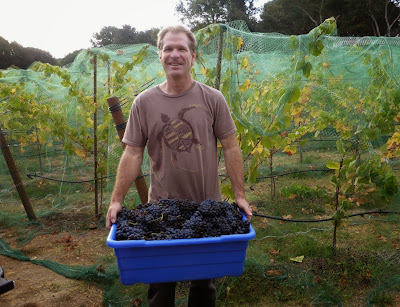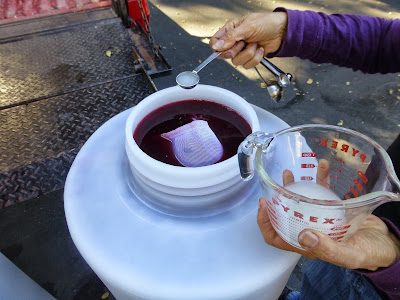 |
| Pinot Noir grapes from our Turtle Vines vineyard in Sebastopol, California. Check out my eBook, Health Begins in the Kitchen. Follow Foods For Long Life on Facebook. |
We've been really busy with harvest and making wine this month so I thought I'd write a little about this other part of my life, when I'm not creating recipes or writing my blog.
Five Fun Facts about Pinot Noir
1. Pinot Noir is the same as French Burgundy
2. The movie Sideways caused the consumption of Pinot Noir to increase and the consumption of Merlot to drop.
3. Pinot Noir is raw and vegan (if not filtered). Fermentation temperatures never get that hot.
4. Pinot is known as the Heartbreak Grape as it requires a lot of attention in every phase of the winemaking process. Andre Tchelistcheff, a famous winemaker, once said, "God made Cabernet Sauvignon, whereas the Devil made Pinot Noir."
5. Some of the best places to grow Pinot Noir are Burgundy France, Sonoma County in California, Willamette Valley in Oregon, Central Otago in New Zealand, Ahr region in Germany, and Northern Italy.
From Silicon Valley to Russian River Valley
My husband Doug and I met 24 years ago in Silicon Valley where we both had stressful jobs in the high tech industry. Collectively we had spent over six decades in the world of engineering - sitting in meetings, working in laboratories or factories, or riding airplanes, never feeling the sun on our backs or breathing fresh air. For as long as we've been together, we talked about moving to the country and starting a vineyard. Five and a half years ago that dream came true.
We found the perfect spot in the small town of Sebastopol, about one hour north of San Francisco. The house needed quite a bit of remodeling and there was just a big empty field behind it which would be the future home of over 3,000 organic Pinot Noir vines. I don't think we realized at the time how much work it would take.
 |
| 2009 - big empty field |
 |
| 2013 - vineyard before harvest with bird netting |
Doug took viticulture and wine making classes at the Santa Rosa junior college. Only in Sonoma county would you find a JC with its own 70 acres of vines, professional wine making equipment, and professors with impressive experience in the wine industry. With the help of some really smart people, we took soil samples, designed the vineyard, selected the precise clones of Pinot Noir to plant, and planted 3,130 healthy little vines.
It took 4 years until our first harvest which yielded a little over one half ton of grapes. This year we harvested two and a half tons. Ultimately our little vineyard will yield over five tons, enough to make three hundred cases of wine. This year we sold two tons of grapes to a local winery that appreciates that our grapes are organic. We saved a half ton to make some wine. I thought it might be fun to show you how we do that!
* * *
Pinot Noir
Raw Vegan, Gluten Free
[makes 1,800 glasses or 360 bottles]
Requirements: a whole bunch of expensive equipment and lots of patience
Ingredients:
1/2 ton ripe Pinot noir grapes
100 pounds of dry ice, divided
120 ppm metabisulfate, (more or less) divided
tartaric acid, as needed
300 g Go-Ferm yeast starter
50 g Assmanshausen or other wine yeast
2.5 g ML culture
Step 1 - Picking the grapes:
Grapes are picked when their sugar content is around 24% (in wine lingo, that's called 24 brix). This is measured by placing grape juice from a carefully selected sample of grapes into a tool called a refractometer.
 |
| Refractometer used to measure brix |
In addition to having the correct brix measurement, the seeds need to be nice and brown. Of course the final criteria for harvesting is that they taste great. The grapes are then picked early in the morning, while they are still cool, and placed in picking lugs that hold about 40 pounds of grapes.
 |
| Doug and a lug of grapes from our 2012 harvest. |
Remove the grapes from their stems. (Some wine makers leave some of the grapes as full clusters). We use a piece of equipment called a destemmer to do this step.
The destemmer sits on top of a fermentation tank. It removes the stems from the grapes and the berries drop into the tank. If some of the stems fall through, make sure to pick them all out.
 |
| Doug pouring grapes into the destemmer. My friends Lauren and John pulling out stems that fell through. |
Step 3 - Cold soaking the grapes
To enhance the color and flavor of the wine, cold soak the grapes for five days. Big wineries do this with cooling coils around the tanks. We do it by placing dry ice in the fermentation tanks which makes it look like a witches cauldron!
 |
| Using dry ice to cold soak the grapes. |
To try and keep the grapes below 50 degrees F, stir in dry ice chunks every day. To prevent spoilage, add a small amount of metabisulfite (30ppm).
Step 4 - Analysis
While the grapes are cold soaking, send the juice out to a laboratory to determine its acid profile, pH, and final brix (hoping that the brix of the entire harvest matches that of your sample).
Step 5 - Adjust the acid
Pinot should have a TA, or titratable acid, of 0.7 to 0.75 grams per liter prior to fermentation. If it's lower than that, you need to add acid. Our TA was 0.55 so we stirred in some tartaric acid.
 |
| Adding tartaric acid. |
Step 6 - Fermentation
Now for the good stuff - the conversion of the natural sugar in the grapes into alcohol.
For this you'll need two things:
* A type of yeast used for wine fermentation - we use Assmanshausen Yeast.
* Added nutrients to enhance fermentation - Go-Ferm Yeast Starter Nutrient
First, add the Go-Ferm to one quart of 110 degree F water. When the solution cools to 102 degrees F, add the yeast. Set the bucket of yeast, water, and Go-Ferm, into the fermentation tank to chill the yeast. Once chilled to within 10 degrees of the grapes, add a little grape must (grapes/juice) into the bucket.
 |
| Bucket of yeast, Go-Ferm, and some grape must. |
Spread the contents of the bucket over the top of the grape must. Leave as is, covered, for 24 hours in order for the yeast colonies to form.
 |
| The light streaks show the yeast solution. |
After 24 hours, start punching down the top of the grapes to keep the skins incorporated into the juice. As fermentation continues, the skins will dry out and separate from the juice forming a thick cap over the fermentation tank. This cap must be punched down about twice a day during fermentation.
 |
| We use this stainless steel grape stomper to punch down. |
Fermentation typically takes from 5 to 10 days. During punch down, measure the juice for its sugar content to see if the yeast are finished converting it to alcohol. A hydrometer is used for this measurement. When it hits zero, the grapes are ready to press.
 |
| The hydrometer looks like a long thermometer. It floats in the juice - when it settles, the % sugar measurement can be read. |
Step 7 - Pressing the grapes
After fermentation, it's time to press. Since we have such a large amount of grapes, we purchased a bladder press. The bladder is in the center of the press and receives water pressure from an ordinary garden hose. When the bladder fills up, it gently squeezes the grapes and the juice pours out of the press.
 |
| Bladder press |
Place the pressed juice in a large container that has been sterilized. We used two forty gallon, food-grade containers. Let it sit for 24 to 48 hours.
Step 8 - Rack off the Gross Lees
After one or two days, sediment will settle out of the wine. The heavy sediment that drops out in first day is called gross lees. Although some wine makers allow the wine to remain on the gross lees for an extended period of time, this could possibly introduce harsh flavors to the wine so many winemakers siphon the wine off of the gross lees into another vessel after one or two days. This is called racking. After racking, the wine is much purer with a small amount of fine lees that, unlike the gross lees, can be beneficial for the wine and becomes a source of nutrients for secondary or malolactic fermentation.
 |
| To rack the wine with a siphon, the pressed wine must be higher than the vessel you are racking into. We raised the pressed wine higher with the lift on the back of our pickup truck. |
Step 9 - Malolactic Fermentation
Pinot noir grapes naturally contain three types of acid - tartaric, citric, and malic. To soften the harshness of malic acid, winemakers initiate Malolactic Fermentation (MLF), a process that turns malic into lactic acid (a softer acid that makes the wine more rounded and drinkable).
Prepare ML bacterial culture. Add 2.5 g of freeze-dried ML powder to 50 g of room temperature water or prepare according to directions. Add solution to racked wine.
Adding Oak during MLF
Adding oak during MLF allows the flavors to better integrate into the wine. Since we do not use oak barrels, we use little oak balls. Yes, I know, oak barrels are romantic and traditional and most winemakers scoff at the thought of using oak adjuct, but hear me out.
Our environmentally friendly, polyethylene, oxygen permeable Flextank is equivalent to a neutral barrel and doesn't impart any flavors into the wine but it breathes. It also removes the risk of a barrel introducing funky flavors or pathogens.
By adding oak balls, or Medium Plus Xoakers, we can select the exact oak flavors we desire.
We did an experiment with 4 types of oak by making extractions (actually martinis). After soaking them for several weeks in vodka, we observed the aromas from each solution and selected the one we liked the most. For us, that was medium plus toasted French oak.
 |
| Medium Plus Xoakers |
 |
| How we selected our oak. |
Add oak Xoakers to the vessel containing the racked wine.
 |
| Place oak balls into Flextank containing racked wine. |
Add the ML bacterial culture to the vessel.
 |
| Adding ML solution. |
Notice that the vessel is filled fairly high to minimize exposure to oxygen.
Malolactic fermentation will begin as soon as the bacterial culture is introduced to the wine.
Stir the wine gently once or twice a week during the fermentation period to get the light lees from the bottom of the tank back into the solution.
Test the wine after about 4 weeks to see if the fermentation is complete.
Once finished, add sulfur to arrest any harmful bacteria. The amount of sulfur will vary with the pH of the wine.
Remove oak Xoakers.
Step 10 - Aging
Pinot can age from 12 to 18 months. Keep your barrel or tank in a cool temperature, around 55 to 60 degrees F.
 |
| Wine aging |
Step 11 - Bottling
Check the pH and TA. If needed, it can be corrected before bottling by adding up to .4 g/l of tartaric acid.
Do one final racking to remove the remaining sediment.
Here's an example of a small bottling machine. It's so easy, even a child can do it!
 |
| This was taken years ago at a friend's house - bottling Rose. |
Let the bottled wine sit for at least 3 months or it may taste bad. This is called "Bottle Shock." There's a great movie by that name that explains this phenomena.
Step 12 - Drink it!
From harvest to opening a bottle of Pinot takes 18 to 24 months. So sit back and enjoy it.
I left some details out but I hope this gave you an idea of how we make our Pinot noir.
Salute!
For more information on growing and making Pinot noir, you can follow Doug's blog about our vineyard, Turtle Vines.







































